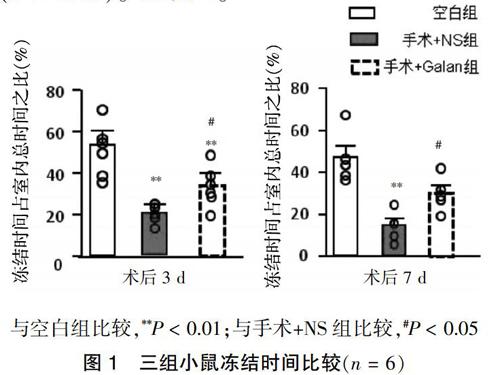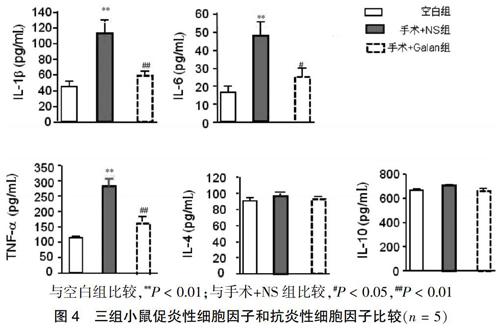增强中枢胆碱能神经系统活性对小鼠术后认知障碍的影响
2019-09-09王天海朱红革侯彦深段文明于婵娟
王天海 朱红革 侯彦深 段文明 于婵娟



[摘要] 目的 評价增强小鼠中枢胆碱能神经系统活性对术后认知功能障碍(POCD)的影响及机制。 方法 选用45只C57BL/6小鼠,采用随机数字表法将其分为三组:空白组、手术+NS组、手术+Galan组,每组15只;后两组行单侧胫骨骨折内固定术建立POCD模型。手术+Galan组术后每日腹腔注射4 mg/kg中枢胆碱能神经活性增强剂加兰他敏干预,手术+NS组每日腹腔注射等量0.9% NaCl。空白组不进行手术及药物干预。术后第3天和第7天使用情景恐惧测试评估三组小鼠学习与记忆的行为学变化;术后第3天检测海马内小胶质细胞活化程度和细胞数量,检测海马区促炎性细胞因子白细胞介素(IL)-1β、IL-6、肿瘤坏死因子-α(TNF-α)和抗炎性细胞因子(IL-4和IL-10)的表达情况。 结果 术后第3天行为学检测中,与空白组比较,手术+NS组和手术+Galan组冻结时间均显著减少(P < 0.01);与手术+Galan组比较,手术+NS组冻结时间减少(P < 0.05)。术后7 d,与空白组比较,手术+NS组冻结时间显著减少(P < 0.01),且手术+NS组冻结时间短于手术+Galan组(P < 0.05),而手术+Galan组与空白组比较,差异无统计学意义(P > 0.05)。术后3 d,手术+NS组分别与空白组和手术+Galan组比较,海马内小胶质细胞数量均显著增加(P < 0.01),但空白组与手术+Galan组比较,差异无统计学意义(P > 0.05)。与空白组比较,手术+NS组IL-1β、IL-6和TNF-α显著升高(P < 0.01),且其IL-1β、IL-6、TNF-α显著高于手术+Galan组(P < 0.01或P < 0.05)。空白组与手术+Galan组IL-1β、IL-6和TNF-α比较,差异无统计学意义(P > 0.05)。三组间IL-4和IL-10比较,差异无统计学意义(P > 0.05)。 结论 加强中枢胆碱能神经系统活性可以通过抑制海马区小胶质细胞的活化,减轻海马区炎性反应,从而改善小鼠术后认知能力。增强中枢胆碱能活性可能是早期POCD的治疗策略。
[关键词] 术后认知功能障碍;胆碱能系统;炎性因子;小胶质细胞
[中图分类号] R749.2 [文献标识码] A [文章编号] 1673-7210(2019)06(c)-0017-05
Effect of enhancing the activity of central cholinergic nervous system on postoperative cognitive dysfunction in mice
WANG Tianhai1 ZHU Hongge2 HOU Yanshen1 DUAN Wenming1 YU Chanjuan1
1.Department of Anesthesiology, the Third Hospital Affiliated to Xinjiang Medical University, Xinjiang Uygur Autonomous Region, Urumqi 830011, China; 2.the Second Department of Pulmonary Medicine, the Third Hospital Affiliated to Xinjiang Medical University, Xinjiang Uygur Autonomous Region, Urumqi 830011, China
[Abstract] Objective To evaluate the effect and mechanism of enhancing the activity of central cholinergic nervous system on postoperative cognitive dysfunction (POCD) in mice. Methods Forty-five C57BL/6 mice were selected and divided into three groups by random number table method, blank group, operation +NS group, operation +Galan group, with 15 mice in each group. The latter two groups underwent internal fixation of unilateral tibial fracture to establish the model of postoperative cognitive dysfunction. In the operation +NS group, 0.9% NaCl was injected into the abdominal cavity every day. Postoperative intraperitoneal injection of central cholinergic neuroactivity enhancer Galan intervention. No surgical or medical intervention was performed in the blank group. The behavioral changes of learning and memory in three groups were assessed by the situational fear test on the third and seventh day after the operation. The activation degree and number of microglia cells in the hippocampus were detected on the third day after the operation. The expression of pro-inflammatory cytokines interleukin (IL)-1β, IL-6 and tumor necrosis factor-α (TNF-α) and anti-inflammatory cytokines (IL-4 and IL-10) in the hippocampus were detected. Results In the behavioral test 3 days after the operation, compared with the blank group, the freezing time in the operation +NS group and the operation +Galan group was significantly reduced (P < 0.01). Compared with the operation +Galan group, the freezing time of the operation +NS group was reduced (P < 0.05). Seven days after the operation, the freezing time of the operation +NS group was significantly reduced compared with the blank group (P < 0.01), and the freezing time of the operation +NS group was shorter than that of the operation +Galan group (P < 0.05), while the difference between the operation +Galan group and the blank group was not statistically significant (P > 0.05). 3 days after the operation, the number of microglia cells in the hippocampus in the operation +NS group was significantly increased compared with the blank group and the operation +Galan group (P < 0.01), but the difference between the blank group and the operation +Galan group was not statistically significant (P > 0.05). Compared with the blank group, IL-1β, IL-6 and TNF-α of the operation +NS group were significantly increased (P < 0.01), and their IL-1β, IL-6 and TNF-α were significantly higher than those of the operation +Galan group (P < 0.01 or P < 0.05). There was no significant difference in IL-1β, IL-6 and TNF-α between the blank group and the operation +Galan group (P > 0.05). There was no significant difference in IL-4 and IL-10 among the three groups (P > 0.05). Conclusion Enhancing the activity of the central cholinergic nervous system can reduce the inflammatory response in the hippocampus by inhibiting the activation of microglia cells in the hippocampus, thus improving the postoperative cognitive ability of mice. Enhancing central cholinergic activity may be a therapeutic strategy for early POCD.
[Key words] Postoperative cognitive dysfunction; Cholinergic system; Inflammatory factors; Microglia
术后认知功能障碍(postoperative cognitive dysfunction,POCD)心脏手术患者罹患多达60%,经常出现在术后几天到1年[1],已成为外科手术患者的主要健康问题。动物实验和临床试验表明,外科手术的创伤是引起POCD的主要因素[2]。然而POCD的确切机制仍不清楚。
研究表明,创伤引起的炎性反应可能是导致术后POCD的重要原因[3]。在外科小鼠血浆和中枢神经系统中,可以发现促炎细胞因子,可能是引起动物学习与记忆损伤的主要原因;胆碱能系统与突触可塑性和学习记忆有关[4],并可以抵消脂多糖对小鼠神经炎症和空间记忆的不利影响[5]。增加中枢胆碱能神经系统功能会对POCD产生什么影响值得探讨,现报道如下:
1 材料与方法
1.1 实验动物
选用45只雄性C57BL/6小鼠[由新疆医科大学实验动物中心提供,动物许可证号:SYXK(新)2016-0003,动物合格证号:65000700001016],年龄10~12个月,自由摄入食物和水。所有动物饲养和实验协议符合实验动物护理和使用指南[6],通过新疆医科大学实验动物资源办公室和动物保护委员会的核准。
1.2 实验动物分组与给药
将实验小鼠采用随机数字表法分为三组:空白组、手术+Galan组、手术+NS组,每组15只;后两组行单侧胫骨骨折内固定术。按Terrando等[7]标准行单侧胫骨骨折手术并采用髓内钉内固定术:小鼠用七氟醚麻醉(4%用于诱导,3%用于麻醉),无菌条件下,左膝盖下方切一个纵向0.5 cm的切口,分离肌肉、暴露胫骨、剥离骨膜;断端以0.38 mL粗、5 mL长不锈钢针插入胫骨髓内腔,冲洗伤口并缝合,然后回笼。手术+Galan组术后每日腹腔注射4 mg/kg中枢胆碱能神经活性增强剂加兰他敏干预;手术+NS组每日腹腔注射等量0.9% NaCl。空白组不进行手术及药物干预。
1.3 行为学检测
恐惧情景记忆按Johansen等[8]的方法进行,有一个训练阶段和两个测试阶段。训练阶段将小鼠置于情景恐惧室中,允许其自由适应120 s;然后音强(70 dB)20 s刺激,最后2 s给予持续0.8 mA足部电击;120 s后,重复1次。训练结束的第3天和第7天测试。测试时小鼠被置于相同的恐惧情景室,适应2 min后。通过跟踪系统监测小鼠的运动,使用视频软件分析冻结姿势时间占室内总时间的百分比;在不同小鼠之间用70%的酒精擦拭实验室。术后第3天,如果检测手术+NS组与空白组小鼠在冻结时间上差异有统计学意义(P < 0.05),则认为胫骨骨折手术可引起小鼠POCD。
1.4 组织化学检测
1.4.1 ELISA法检测蛋白 ELISA试剂盒(中国上海赛默飞世尔科技有限公司生产)检测炎性细胞因子白细胞介素(IL)-1β、IL-6和肿瘤坏死因子-α(TNF-α)和抗炎性细胞因子(IL-4和IL-10),按说明书对小鼠用CO2进行安乐死,取海马组织,立即液氮冷冻,储存至-80℃直到使用。样品中使用Ripa裂解液溶解和萃取缓冲器提取总蛋白质。蛋白质浓度的测定采用BCA蛋白浓度测试法(检测试剂盒:中国上海碧云天生物技术有限公司生产)。100 μL样品(200 μg蛋白质)成倍稀释,取450 nm波長测定样品的吸光度,在标准曲线上读取样本蛋白质的数值(pg/mL)。
1.4.2 免疫组织化学 用CO2对C57BL/6小鼠进行安乐死,用含肝素4%多聚甲醛磷酸缓冲盐(PBS)液7 mL和PBS液35 mL进行心脏灌注。然后取小鼠脑组织,用振动切片机切片,切片厚度50 μm,放置在载玻片上。室温干燥,冷冻至-20℃。冷冻切片在室温解冻15 min,用4℃ PBS液洗涤2次,每次10 min,在含聚乙二醇辛基苯基醚的PBS液室温放置1 h,在10%驴血清的PBS液固定45 min,在PBS中孵育初级1∶500离子钙接头蛋白(Iba-1)抗体(日本和光纯药株式会社生产)。4%驴血清PBS中洗涤3次(15 min/次),在4℃放置18 h。在室温下4%的1∶500驴血清PBS中孵育二次抗体(美国Jackson Immunology公司生产),孵育1 h,样本在室温下PBS洗涤3次(15 min/次),室温下浸入封装剂(美国Vector公司生产),然后覆盖盖玻片。
共聚焦显微镜(Fv-1000,Olympus)对切片进行成像,使用10×Plan Apo物镜(数值孔径:0.45)和20 × Plan Apo物镜(数值孔径:0.75)。采用561 nm波长激光激发Cy3抗体,在580~640 nm之间检测发光细胞。计数Iba-1阳性细胞数量[9]。
1.5 统计学方法
使用SigMAPLE 11(SPSS公司)绘制图表并进行统计分析,计量资料采用均数±标准差(x±s)表示,三组间比较采用单因素方差分析,组间两两比较采用LSD-t检验。以P < 0.05为差异有统计学意义。
2 结果
2.1 三组小鼠冻结时间比较
采用恐惧情景记忆进行检测。术后3 d,三组比较,差异有统计学意义(F = 22.6,P < 0.001)。手术+NS组和手术+Galan组与空白组比较,冻结时间均显著减少(P < 0.01);手术+NS组短于手术+Galan组(P < 0.05)。术后7 d,三组比较,差异有统计学意义(F = 10.8,P < 0.001)。与空白组比较,手术+NS组冻结时间显著减少(P < 0.01),且短于手术+Galan组(P < 0.05),而手术+Galan组与空白组比较,差异无统计学意义(P > 0.05)。见图1。
2.2 三组小鼠海马CA1区内小胶质细胞数量比较
术后3 d,与空白组比较,手术+NS组海马内小胶质细胞大量激活,手术+Galan组减弱了小胶质细胞的激活(图2,封四)。术后3 d,三组比较,差异有统计学意义(F = 18.6,P = 0.002)。与空白组比较,手术+NS组海马内小胶质细胞数量明显增加(P < 0.01)。与手术+NS组比较,手术+Galan组海马CA1区内小胶质细胞数量显著减少(P < 0.01),但空白组与手术+Galan组比较,差异无统计学意义(P > 0.05)。见图3。
2.3三组小鼠促炎性细胞因子和抗炎性细胞因子比较
三组IL-1β、IL-6、TNF-α比较,差异有统计学意义(F = 11.4,P < 0.001;F = 8.2,P = 0.006;F = 26.3,P < 0.001)。与空白组比较,手术+NS组IL-1β、IL-6和TNF-α显著升高(P < 0.01),且手术+NS组IL-1β、IL-6和TNF-α显著高于手术+Galan组(P < 0.01或P < 0.05)。空白组与手术+Galan组IL-1β、IL-6和TNF-α比较,差异无统计学意义(P > 0.05)。三组IL-4、IL-10比较,差异无统计学意义(F = 1.63,P = 0.240;F = 1.85,P = 0.200)。见图4。
3 讨论
本研究使用七氟醚麻醉下建立10~12个月龄POCD小鼠胫骨单侧稳定骨折手术模型。与国内外相关学者研究相符[10]。本研究中观察到了成年手术小鼠的学习记忆受损。避免使用年轻或老年小鼠[11-12]非挥发性全身麻醉药[13]。本研究使用成年小鼠和七氟醚麻醉来消除影响POCD的混杂因素,对照组通过使用相同浓度的七氟醚和相同持续时间的麻醉,保持了相似的麻醉深度。因此,在本研究中影响实验结果的因素主要来自手术和药物干预本身。
情景恐惧测试通常用于评价小鼠的学习记忆变化。在恐惧条件反射建立之后进行手术建立POCD模型,可以反映手术引起小鼠学习与记忆的变化。术后3 d观察到学习记忆减退,同时观察到海马中的IL-1β、TNF-α、IL-6促炎性因子表达增高,还发现海马区小胶质细胞在海马区有明显的聚集。啮齿类动物模型表明,手术创伤导致血液免疫细胞(如巨噬细胞)通过短暂的渗透性血脑屏障渗入大脑;浸润的免疫细胞与小胶质细胞之间的紧密交叉可能导致海马体的神经炎症。神经炎症的其他机制可能包括外周细胞因子穿过血脑屏障并刺激海马中的小胶质细胞。有研究[14-15]推测,术后海马的神经炎症可能是POCD的重要因素;阻断或敲除IL-1β受体或用抗体中和TNF-α可减轻外科啮齿动物海马的神经炎症和记忆缺陷[16];因IL-1可维持海马的突触可塑性,而TNF-α和IL-6负调节海马的突触可塑性[17],而抗炎药改善啮齿动物记忆障碍[18]。因此减轻促炎细胞因子的释放可能是缓解POCD的策略。
胆碱能系统是一种机体内源性消除炎性反应的有效途径。术前大剂量使用减弱中枢胆碱能神经系统的药物可以增加术后罹患认知功能障碍的风险[19];增强这个系统可以减少神经炎症。有报道[20],手术导致胆碱乙酰转移酶(乙酰胆碱合成酶)下调,加强胆碱能系统能减轻中枢炎性反应的程度和改善POCD的症状。本研究发现加兰他敏减轻了小胶质细胞在海马体中的积聚,降低了海马区炎性因子的水平,显著改善了手术小鼠学习记忆的损伤。但是加强手术小鼠胆碱能神经活性通过何种机制减轻小胶质细胞的激活和减少炎性因子的释放,需要进一步研究。
综上所述,手术创伤引起小鼠中枢海马区炎性因子释放及小胶质细胞激活,损伤手术小鼠的学习记忆能力,通过增强小鼠的中枢胆碱能神经系统活性,可缓解中枢海马区的炎性反应,改善小鼠的学习记忆能力。
[参考文献]
[1] Brown C,Deiner S. Perioperative cognitive protection [J]. Br J Anaesth,2016,117(suppl 3):iii52-iii61.
[2] Riedel B,Browne K,Silbert B. Cerebral protection:inflammation,endothelial dysfunction,and postoperative cognitive dysfunction [J]. Curr Opin Anaesthesiol,2014,27(1):89-97.
[3] 何毅,于嬋娟,刘亚华.老年大鼠海马TLR4通路在胫骨手术导致的术后认知功能障碍中的作用研究[J].新疆医科大学学报,2018,41(3):330-333.
[4] Alonaizi MA,Parfitt GM,Kolisnyk B,et al. Regulation of Cognitive Processing by Hippocampal Cholinergic Tone [J]. Cereb Cortex,2017,27(2):1615-1628.
[5] National Research Council (US) Committee for the Update of the Guide for the Care and Use of Laboratory Animals. Guide for the Care and Use of Laboratory Animals [M]. 8th edition. Washington (DC):National Academies Press (US),2011:1-247.
[6] Liu Y,Zhang Y,Zheng X,et al. Galantamine improves cognition,hippocampal inflammation,and synaptic plasticity impairments induced by lipopolysaccharide in mice [J]. J Neuroinflammation,2018,15(1):112-116.
[7] Terrando N,Brzezinski M,Degos V,et al. Perioperative Cognitive Decline in the Aging Population [J]. Mayo Clin Proc,2011,86(9):885-893.
[8] Johansen JP,Cain CK,Ostroff LE,et al. Molecular mechanisms of fear learning and memory [J]. Cell,2011,147(3):509-524.
[9] Schneider CA,Rasband WS,Eliceiri KW. NIH Image to ImageJ:25 years of image analysis [J]. Nat Methods,2012,9(7):671-675.
[10] Vacas S,Degos V,Maze M. Fragmented Sleep Enhances Postoperative Neuroinflammation but Not Cognitive Dysfunction [J]. Anesth Analg,2016,124(1):270-276.
[11] Xin Y,Liu H,Zhang P,et al. Molecular hydrogen inhalation attenuates postoperative cognitive impairment in rats [J]. Neuroreport,2017,28(11):1-4.
[12] Evered L,Scott DA,Silbert B. Cognitive decline associated with anesthesia and surgery in the elderly:does this contribute to dementia prevalence? [J]. Curr Opin Psychiatry,2017,30(3):220-225.
[13] Schoen J,Husemann L,Tiemeyer C,et al. Cognitive function after sevoflurane- vs propofol-based anaesthesia for on-pump cardiac surgery:a randomized controlled trial [J]. Br J Anaesth,2011,106(6):840-850.
[14] Terrando N,Eriksson LI,Ryu JK,et al. Resolving postoperative neuroinflammation and cognitive decline [J]. Ann Neurol,2011,70(6):986-995.
[15] Zhu YJ,Peng K,Meng XW,et al. Attenuation of neuroinflammation by dexmedetomidine is associated with activation of a cholinergic anti-inflammatory pathway in a rat tibial fracture model [J]. Brain Res,2016,1644:1-8. DOI:10.1016/j.brainres.2016.04.074
[16] Cibelli M,Fidalgo AN,Ma D,et al. Role of interleukin-1beta in postoperative cognitive dysfunction [J]. Ann Neurol, 2010,68(3):360-368.
[17] Arisi GM. Nervous and immune systems signals and connections:Cytokines in hippocampus physiology and pathology [J]. Epilepsy Behav,2014,38:43-47. DOI:10.1016/j.yebeh.2014.01.017
[18] Xiong B,Shi Q,Fang H. Dexmedetomidine alleviates postoperative cognitive dysfunction by inhibiting neuron excitation in aged rats [J]. Am J Transl Res,2016,8(1):70-80.
[19] 吳林纳,孟海兵,丁国友.长托宁对老年冠心病患者腹部手术后早期认知功能的影响[J].中国医药导报,2014(35):15-19.
[20] Winland CD,Welsh N,Sepulveda-Rodriguez A,et al. Inflammation alters AMPA-stimulated calcium responses in dorsal striatal D2 but not D1 spiny projection neurons [J]. Eur J Neurosci,2017,46(9):2519-2533.
